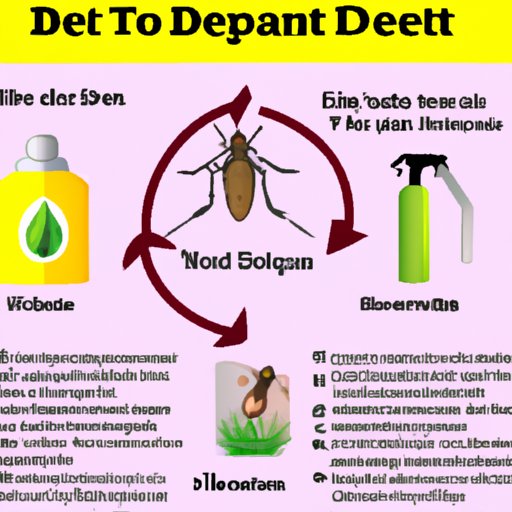Introduction
DEET is a chemical used in insect repellents to protect humans from mosquitoes, ticks, and other biting insects. It has been used since the 1940s and is one of the most widely used insect repellents on the market today. In this article, we will explore the science behind DEET and how it works to repel insects.
Exploring the Science Behind DEET: How Does it Work?
DEET stands for N,N-Diethyl-meta-toluamide, and it is a colorless, odorless chemical compound. It is synthesized from toluene, a petroleum byproduct. The chemical composition of DEET gives it a unique set of properties that make it an effective insect repellent.
DEET works by blocking the receptors in insects’ antennae that detect human odors. When DEET is applied to skin or clothing, it creates a thin layer of invisible particles that mask the scent of the human body. Without being able to detect human scent, insects are unable to locate their target and will fly away.
How DEET Protects You from Insects, Mosquitoes and Ticks
DEET is effective against several different types of insects, including mosquitoes, ticks, fleas, chiggers, and flies. However, the concentration of DEET needed to repel each type of insect varies. For example, a product with a 10% concentration of DEET may be enough to repel mosquitoes, while a 30% concentration may be necessary to ward off ticks.
In addition, DEET is more effective when applied to clothing rather than directly to the skin. This helps to keep the repellent active and prevents it from evaporating quickly. It is important to note that DEET should never be applied directly to eyes, mouth, or broken skin.

The Pros and Cons of Using DEET for Insect Repellent
Using DEET as an insect repellent has both advantages and disadvantages. On the plus side, DEET is highly effective at repelling insects and has been proven safe for use on adults and children over two months of age. It also has a long-lasting effect, depending on the concentration of DEET used.
On the downside, DEET can cause skin irritation in some people, and it has a strong odor that may be unpleasant to some. It is also possible for DEET to damage certain materials, such as plastics and painted surfaces, if it comes into contact with them.
A Comprehensive Guide to Understanding DEET
To ensure maximum effectiveness and safety when using DEET, it is important to follow the instructions provided on the product label. Here are some tips to keep in mind when using DEET:
- Apply DEET only to exposed skin and never to wounds or irritated skin.
- Do not apply DEET to clothing, as it can damage certain materials.
- Reapply DEET every few hours for optimal protection.
- Wash off DEET after returning indoors.
- Keep DEET away from the eyes, nose, and mouth.
It is also important to note that DEET should not be inhaled or ingested. If you have any questions about the product, consult your doctor or pharmacist before using it.
Is DEET Safe? A Look at the Risks and Benefits of DEET-Based Insect Repellents
Despite its widespread use, there are still some concerns about the safety of DEET. Some studies have suggested that prolonged exposure to DEET can cause neurological damage, particularly in young children. It is also possible for DEET to cause skin irritation in some people.
However, DEET is generally considered to be safe and effective when used as directed. The American Academy of Pediatrics has given DEET its seal of approval, and the Environmental Protection Agency (EPA) has approved DEET for use on humans of all ages.
Conclusion
DEET is one of the most effective and widely used insect repellents on the market today. It works by blocking the receptors in insects’ antennae that detect human odors, which makes it difficult for them to find their target. DEET can be used to repel a variety of insects, but the concentration of DEET needed to repel each type of insect varies. While DEET is generally considered safe when used as directed, it is important to follow the instructions on the product label and avoid prolonged exposure to DEET.
In conclusion, understanding how DEET works and following the proper usage guidelines is key to ensuring maximum effectiveness and safety when using DEET-based insect repellents.
(Note: Is this article not meeting your expectations? Do you have knowledge or insights to share? Unlock new opportunities and expand your reach by joining our authors team. Click Registration to join us and share your expertise with our readers.)
